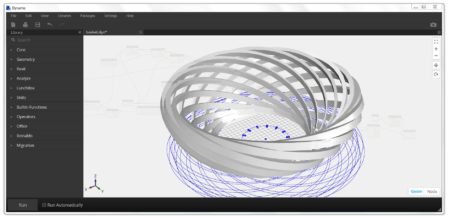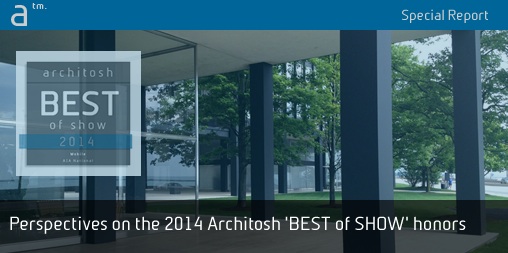Continued from page 1
Reviewing the Winners
On the Desktop Winner(s)
This year’s first winner in this category won over others for its sheer virtuosity in programming ambition and execution, which is something we noted last year wasn’t necessary going to be the focus of this program. Despite this, certain innovations are worth noting and Vectoroworks Architect 2014‘s new Vectorworks Graphics Module bodes extremely well for this leading BIM and CAD tool. Already, Vectorworks utilizes the world’s leading geometry modeling kernel in Siemens’ Parasolid. Interestingly, the decision to home-grow their own advanced OpenGL rendering engine with aspects that are similar to both HOOPS (a rival rendering API technology) and the well regarded Unity Game Engine was an interesting turn of events.

01 – Dynamo 0.7.x alpha holds new power now that it contains Autodesk’s full geometry modeling kernel. (image courtesy of Dynamo blog. All rights reserved)
The second honor in Autodesk Dynamo with particular emphasis on version 0.7 alpha acknowledges many of the latest important trends, including social in its open-sourced ambitions. It was particularly valuable to see that this latest alpha version contains Autodesk’s own modeling geometry engine (ASM) and is even more capable of direct modeling and that the stand-alone version doesn’t require Revit. In fact, Dynamo 0.7.x has nearly full access to the ASM geometry kernel, the same library that powers Inventor, Fusion, AutoCAD and other Autodesk products. Openness may drive further appeal for those utilizing Generative Components or Grasshopper. Computation-based modeling doesn’t just afford architects with more aesthetic possibilities, such tools also lay the basis for performance based design.
On the Mobile Winner(s)
BIMx Docs is a beautifully executed 3D application on mobile that links the experience of a 3D virtual building, a world unto itself, with the visual world of 2D drawings. And it does it with an engaging animated experience that invites an iterative exploration of both the BIM model and the drawings that are generated from it. Architects can now bring their ArchiCAD BIM projects into the field complete with the drawings and the BIM model. In Japan GRAPHISOFT noted where BIMx Docs will go in the future with respect to data and its BIMcloud technology. BIMx Docs has a very bright future.
And so does Autodesk FormIt with its continued refinement of an app that enables conceptual architectural modeling directly on map-based sites with local climate station data that can help power early stage building performance based design investigation. Front-ending analytics is an extremely important growth vector affecting the left side of the effort bubble in the famous MacLeamy Curve. As tablet computers gain more power in hardware as well as tap the power of cloud-based computing resources, many possibilities begin to take shape.
On the BIM Winner(s)
With a particular focus on where technology investment is happening relative to the MacLeamy Curve, up-front analysis naturally makes the most sense as this is the stage where the architect can have the biggest impact at the lowest cost. For years architects have designed structures and then engineers ran calculations to verify performance. If the performance didn’t meet design intent goals the architect would redesign and repeat the process. This produced waste.
Advertisement
This technology is now entering the architect’s workflow early—even in more rudimentary form—where architects can make more informed early decisions. This leads to earlier insight and to architects having the ability to design higher performing buildings faster and with more control over the relationships within a structure. Leading the charge is Sefaira’s web and plugin technology and specifically its SketchUp plugin. Sefaira puts computational heavy analysis up front in the design process directly into an iterative design tool in Trimble’s SketchUp modeler. Architects can evaluate energy implications and lighting within every push-pull of the model at every turn. This is, in fact, the future of design.
Graphisoft’s BIMcloud is a superior piece of technology implementation of its patented Delta Server™ technology. The Hungarian BIM pioneer is arguably very far ahead of the entire field in one particular area of BIM—real-time collaborative team technology that works across oceans and continents all over typical Internet connections. ArchiCAD 18 with BIMcloud furthers this ability by adding real-time scalability to massive BIM projects by harnessing the infinite power of the cloud. Both BIM winners this year are squarely exemplify the computational power of the cloud.
On the Innovation Winner(s)
So what is the most promising and most innovative new information technology (IT) at the AIA this year? What’s going to have a really big impact moving forward, conceptually and as an implementation of that concept?
Sefaira’s tools and technology are clearly leading the charge in “front-ending analytics”, a term that popped up at the Autodesk Innovation Forum at AIA this year. It’s a very good term and describes well the push to the left on the MacLeamy Curve where analytics computation—of the type typically done by engineers and sometimes scientists—is being delivered in a form to architects via easy to use software tools for design. What’s chiefly valuable up front is insight on energy performance and daylighting. Both are major factors in the sustainability equation. At AIA National in Chicago Sefaira was the coolest toolset delivering value in this area.
Another important factor in sustainability is the weight of the building itself. Like aircraft design where “lighter” is the new king, buildings that use lighter materials—especially those materials that are hidden inside the building itself—contribute a good to the environment in reduced carbon emissions in the transportation of those materials from the point of manufacturer to the construction site and all points in between (think staging and warehousing). This is where Altair Corporation’s technology is coming into play. Noted last year in Denver for its first-time entry at AIA National, the company was in attendance this year touting its many technologies. solidThinking Inspire 2014 is an interesting tool that can enable architects to work at both the building and the building product level to tackle the problem of weight reduction in efficient structural design.
In the case of Inspire 2014, the honor is more directed at the “promising” aspect of the technology. When we talk about front-ending analytics in the design process, Altair’s technology has tremendous potential in AEC. For the average Joe architect, this tech may not apply, like Sefaira’s tools. At least not just yet. But for the special projects category of creative structures solidThinking Inspire 2014 has much to offer.
Closing Comments
These 2014 Architosh BEST of SHOW at AIA National honors recognize tools that are exemplifying the cutting edge of the IT landscape in AEC. While there were many other interesting software tools—like the areas of photo-realistic rendering—these types of tools, mostly, are on sustaining innovation trajectories that have been well defined for years. Most of the tools cited above are on innovation trajectories that are so new the field isn’t sure which ones are disruptive or not. And which ones will leave an indelible mark on the nature of the profession and its history. Will architects see the possibilities in these tools and embrace them for the betterment of society and their profession? Or will the stick with the status quo, limiting their potential for engagement and change?




Reader Comments
#CAD Perspectives on the 2014 Architosh BEST of SHOW awards at AIA National http://t.co/4vw6HUFutC
#CAD Perspectives on the 2014 Architosh BEST of SHOW awards at AIA National http://t.co/4vw6HUFutC
Comments are closed.